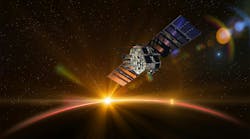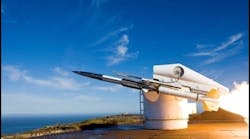For nearly three decades the U.S. space shuttle carried NASA's astronauts to space and was the forefront of America's space program. It is set to retire in 2010, still flying with some of its original 1970s technology, which was developed long before NASA and the U.S. military looked to buy commercial-off-the-shelf (COTS) space technology wherever and whenever possible.
Following on the heels of the Apollo program, which landed astronauts on the moon, the space shuttle was well funded and could afford to design systems from the ground up.
The shuttle's successor, the Orion Crew Exploration Vehicle program, is modernizing spacecraft cockpit avionics. The new Orion Crew Exploration Vehicle (CEV) will have a technology roadmap that ensures the latest technology will have an upgrade path for the next 30 years. Orion is part of NASA's Constellation program to send humans into space cost effectively, according to the NASA Constellation homepage.
"The technology going into Orion is amazing," says Rick Kasuda, Orion avionics and software director for Lockheed Martin Space Systems Co. in Littleton, Colo. "This is the best technology astronauts have ever had in the cockpit and "quite different from what they had in the space shuttle," he adds.
"Orion is flexible," Kasuda says. It can dock with the International Space Station, bring crew to the lunar surface, then autonomously orbit the moon, he continues. Eventually it will also fly crew to Mars and even visit an asteroid if need be.
The CEV will launch on the Ares I rocket; the Ares V cargo rocket will serve as the heavy lift vehicle for NASA, Kasuda says. NASA is still defining requirements for the Ares V spacecraft, Kasuda says.
The space shuttle carried crew as well as cargo. NASA is separating crew and cargo in the Ares rocket programs for the safety of the astronauts, says Mitch Fletcher, chief systems engineer for human space business at Honeywell. Orion was designed with safety first, "after the shuttle program lost two spacecraft and 14 astronauts," he says.
Lockheed Martin is the prime for the Orion CEV and together with Honeywell in Glendale, Ariz., is designing the avionics for the spacecraft.
The Orion CEV will launch for the first time in 2015, and will dock with the International Space Station, Fletcher says. NASA is also planning to add a second docking station to the International Space Station instead of designing a crew escape vehicle, Fletcher notes. "They find this solution more economical."
The space shuttle may also get a one- or two-year extension to "fill the gap" between now and 2015, says Dennis Donati, director of human space business for Honeywell. "We are involved in the avionics suites of the space shuttle, International Space Station, and the Orion CEV," Donati says. Honeywell also is designing the avionics for the Lunar Lander and Lunar Base Surface System.
Using existing, proven technology
As a systems integrator, Lockheed Martin tries to subcontract out as much as possible, Kasuda says. The Orion spacecraft drives the packaging of that technology through its unique requirements. "We looked throughout our organization for current technology that could be reused and repackaged for space," Donati says. "However, I prefer the term non-specific design technology to COTS [commercial-off-the-shelf]," because it more accurately defines how Honeywell designed the avionics for the spacecraft. It is a low risk approach and NASA liked it. It helps keep pace with standards and technology and "NASA does onto have to flip the bill."
Honeywell has avionics technology in Boeing 777 and 787 commercial jetliners, as well as in Embraer business jets, Fletcher says.
Specifically Honeywell engineers looked at the Embraer jet avionics and how they stayed cost competitive while maintaining top-level performance, Fletcher continues. For their high-integrity flight computers they used one third the hardware at one third the cost by putting all the capability into one box instead of using multiple boards and components from multiple third party vendors, he explains.
Honeywell engineers developed their computers in house and on the Orion are designing the "primary and secondary high-integrity flight computers," Fletcher says. The Honeywell computers use a PowerPC 750 processor based on silicon on insulator (SOI) process, Fletcher says. The SOI material is inherently radiation tolerant, he adds.
A third computer, from Lockheed Martin, is a backup, so that a malfunction in the first two computers will not affect the third. If both primary computers fail, astronauts will use the third computer to restart the mission or fly home, Kasuda says.
CEV designers are also developing "a prototype network router card that is Internet Protocol-based, giving the CEV its own local area network," Kasuda says. Honeywell also looked to its commercial aircraft avionics and space shuttle experience for the Orion CEV's cockpit displays.
Engineers will have a glass cockpit with very few switches to display information from gauges and dials. It has the newest displays that go in the Boeing 777 cockpits, and is twice the size of the Multifunction Electronic Display Subsystem (MEDS) on the space shuttle, Fletcher says. The Orion CEV's three displays measure eight by 10 inches -- or the size of a standard sheet of paper, he explains. The MEDS displays measure five by seven inches.
The MEDS upgrade swapped out the old shuttle cockpit's mechanical and analog instruments and cathode-ray-tube displays and replaced them with software-driven multifunction liquid-crystal displays (LCDs). Nine displays made up the MEDS upgrade, while only three will be used in Orion, Fletcher notes.
The new display system will bring state-of-the-art situational awareness to the astronauts, Donati says. It has brightness and clarity, which is typically what the astronauts care most about, he adds. Honeywell is also looking at ways make this display capability portable for use in the astronauts' space suits, Fletcher says.
"Other aspects are still being worked out and defined by NASA as we go along in this process, Donati says. The displays may have other unique features based on future mission requirements, he adds.
Guidance and navigation
Lockheed Martin is also providing the guidance and navigation instruments to the Orion CEV, Kasuda says. The company is contracting with Ball Aerospace in Boulder, Colo., to provide the boxes for the star tracker, visual navigation sensor, and docking camera, Kasuda says. The star tracker triangulates the position of the stars to measure absolute attitude.
The visual navigation sensor uses flash lidar (light detection and ranging) to guide the spacecraft into dock on the International Space Station, he says. The docking camera provides the crew with a visual of the process, Kasuda adds. Lockheed Martin is also designing a phased array antenna for the communications system, Kasuda notes.
Obsolescence
The high-performance commercial electronics bring many benefits but also create major headaches for designers who need to manage their inevitable obsolescence. "Obsolescence is a huge challenge for us," Kasuda says. "We are looking at spacecraft that will last 30 years with products that become obsolete in five years."
Fletcher notes that the original Honeywell avionics and other components for the space shuttle "were quite robust as well so there are still tons of spares available." Fletcher worked on the original shuttle program back in the 1970s. There are less than a handful of those experts still on the job, he says.
Today it is about implementing open architectures and remaining cost competitive, Fletcher continues. "Technology wise we implemented an open system based on standards for the computers and the software," he adds. "Each can be upgraded without changing the other pieces, he says. "In other words each module of the system is independent and abstract from the others."
It is a similar concept to secure portioned operating systems, Fletcher says. They separate software applications so that if one is adversely affected it doesn't affect the rest of the operating system, he explains.
Lockheed Martin manages the life cycle by buying parts block by block, Kasuda says. When one goes obsolete, a new one is integrated. It should not affect the rest of the system as it is open architecture process, but in a rare case a significant part of the system could be redesigned to handle a life cycle problem. "When we go through the selection process we make sure the supplier will still be around in 20 years," he says. "The open architecture should help with most bumps in the road."
Radiation, shock, and vibration
The displays and computers need to be modified to meet the harsh environment of space. Making electronics radiation resistant for space is traditionally a labor-intensive, multi-year process, but that is cost-prohibitive in today's funding environment, Kasuda says.
Microprocessor cores have helped shrink the design time because they can be bought and put on a custom ASIC (application specific integrated circuit), Fletcher says. The process now is at about two years, he adds. In the old days of the shuttle program, electronics had to be completely resistant to radiation, now they need to be more radiation tolerant than radiation-hardened, Fletcher says.
"We search for parts that have inherent radiation tolerance, then upscreen them for space, Kasuda says. "Upscreening dramatically cuts back on design time," he adds.
Electronics in space suffer more severely from shock and vibration than radiation, Kasuda says. It is the G force from the vibration of the rocket motor and its acoustics, he adds. On an aircraft they only have to withstand 2 Gs, but on a spacecraft its 17 Gs, Fletcher says.
The CEV's launch-abort system alone generates five seconds of thrust, which violently shakes the electronics, Kasuda continues. The system is designed to lift the crew module away from the launch vehicle to save the crew in case of an emergency, he adds. It was based on a similar system for the Apollo program, Kasuda notes.
According to a Lockheed Martin announcement, the abort motor uses a composite case, and exhaust turn-flow technology rather than a tower, which results in weight savings, improved performance, and improved success in crew survival during an abort. Instead of the rocket plume exiting straight out a nozzle at the aft end, the manifold is placed at the forward end of the motor.
Alliant Techsystems (ATK) in Promontory, Utah, designed the launch motor under a contract to Orbital Sciences Corp in Dulles, Va. Alliant officials performed the first test of the motor in November. It was the first test of such a system since the Apollo program performed its test of a launch abort system in the 1960s.
Orbital is responsible for integrating the LAS motor for Lockheed Martin. The Orion Launch Abort System (LAS) program is managed out of NASA's Langley Research Center in Hampton, Va.


